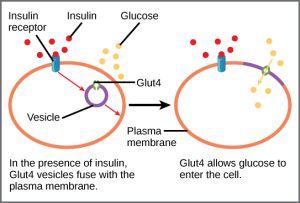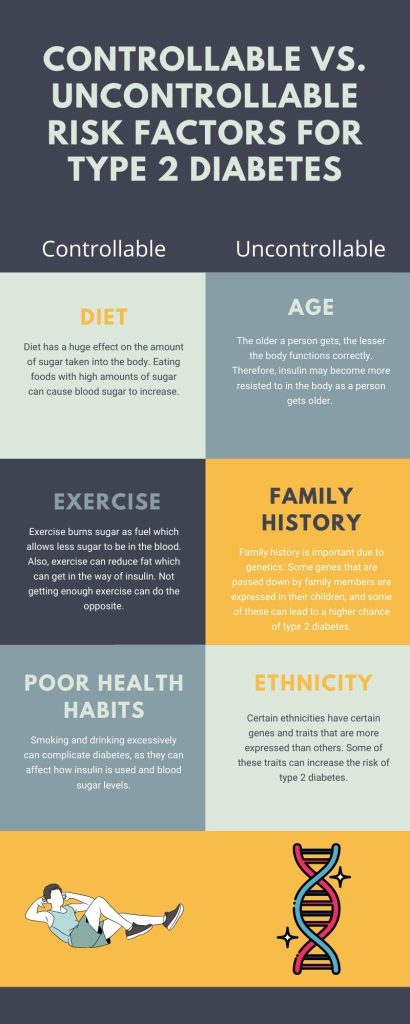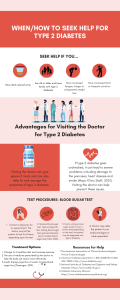Mytchell Ernst
Introduction
Diabetes is a common disease that causes too much sugar to build up in the bloodstream due to the hormone insulin not working correctly or not being present. There are two types, type 1, which is insulin-dependent (meaning the body produces no insulin), and type 2, which is non-insulin-dependent (meaning the body still produces some insulin). Type 2 diabetes is more preventable and common than type 1. Around 32 million people have type 2 diabetes, with about half being women and half being men (American Diabetes Association, 2018; CDC, 2019). This disease can have serious effects on certain parts of the body and can therefore be very dangerous if not taken care of. Although type 2 diabetes is found in men and women at about the same rate, there are certain issues that specifically affect men. Therefore, it is important for males to understand all about type 2 diabetes.
What is Type 2 Diabetes?
Type 2 diabetes is a disease that affects the way the body regulates the fuel known as glucose (also known as blood sugar) (Mayo Clinic Staff, 2021). In the body, the hormone called insulin helps move sugar out of the blood and into either cells or storage. Type 2 diabetes is caused either when cells that take in sugar are unable to respond to insulin as well, or when the body does not create enough insulin. Think of insulin as a key that opens the door to allow sugar to go into cells. If there are not enough keys, then cells will be unable to take in sugar, or if the keyhole is broken, then the key will no longer work as well. This causes there to be too much sugar in the blood, which can damage the body.

Risk Factors of Type 2 Diabetes
There are many risk factors that can lead to type 2 diabetes, some of which are exclusive to men. Common risk factors identified by the CDC (2019) include: prediabetes, age of 45 years or older, overweight, limited exercise, and having a direct family member with type 2 diabetes. Certain ethnicities are also more at risk for type 2, with African Americans, Hispanic/Latinos, American Indians, and Alaskan Natives at the highest risk, and Asian Americans and Pacific Islanders having a moderate risk (CDC, 2019).
Understanding these risk factors is beneficial in learning how to prevent oneself from getting type 2 diabetes. Diet and exercise are necessary examples of controllable risk factors due to their effects on outcomes of sugar in the blood. Age is an important risk factor because as one ages, insulin doesn’t work as effectively, which can lead to higher blood sugar levels. Family history as well as ethnicity play roles in type 2 due to genetics. Certain ethnicities have specific genes, or traits, as well as practices that make them more likely to get type 2 than those of other ethnicities. If a parent has type 2 diabetes, then their children and grandchildren will have an increased risk of this disease.

Specific Risk Factors for Men
While most risk factors for type 2 diabetes are shared for men and women, men have some specific issues that could be considered risks for type 2. One specific risk factor is that men who have low levels of testosterone (the primary male hormone) may have a higher risk of getting type 2 (Diabetes.co.uk, 2019). Lower testosterone can result in higher amounts of fat, which can cause more sugar to be in the blood, or more resistance to insulin. Another male risk factor is that men have lower HDL cholesterol levels than women (Mayo Clinic Staff, 2021). HDL cholesterol often protects the body by moving cholesterol from certain body parts to the liver for it to be removed (See Cholesterol chapter for more information). Therefore, since men have lower rates of HDLs than women, they tend to have more cholesterol, and, as a result, have a higher risk of type 2.
Signs and Symptoms
There are many signs and symptoms of type 2 diabetes that can help to determine whether a person has this disease. Common signs and symptoms listed by the Mayo Clinic (2021) include, “…increased thirst, frequent urination, increased hunger, unintended weight loss, fatigue…” and “…blurred vision…”(Mayo Clinic Staff, 2021). They can also include “…slow-healing sores, frequent infection, numbness or tingling in the hands or feet…” and “…areas of darkened skin, usually in the armpits and neck” (Mayo Clinic Staff, 2021).
These signs and symptoms generally result from the high amounts of sugar in the blood, and the low amounts of sugar in the cells caused by insulin resistance. Increased hunger, fatigue, weight loss, and slow healing are common symptoms that occur when cells are not getting the fuel they need. Increased thirst and frequent urination generally are due to too much sugar being in the blood. These signs and symptoms should be shared with a doctor to determine whether a person has type 2 diabetes.
Specified Issues for Men Resulting From Type 2 Diabetes
Men often have various issues that result from type 2 diabetes. One common issue is low testosterone. While low testosterone is often seen as a risk factor for type 2, type 2 can also cause a decrease in testosterone. As described in the Hormone chapter, low testosterone can cause lower energy, depression, a decrease in muscle mass, and a decrease in sex drive (Zahed, 2020). Another issue that men distinctively deal with when they have type 2 diabetes is erectile dysfunction (ED). Having high blood sugar can cause nerve damage, as well as damage to blood vessels, which can affect a male’s ability to get an erection (Zahed, 2020). Medicine that is used to treat type 2 can also cause ED, so talking to a doctor about a certain medicine’s side effects can help prevent this issue (Zahed, 2020). Another issue that men respectively deal with from type 2 diabetes are urinary tract infections (UTI). UTIs result because of nerve damage in the bladder and urinary tract due to having too much sugar in the blood. These can turn very serious if they are not dealt with immediately and can even cause cancers in the bladder and kidneys. Prostate cancer, a type of cancer that is only found in men, is also known to be linked to type 2 diabetes (Prostate Cancer). Some other issues not exclusive to men include increased risk of heart disease, eye damage, amputations of the arms/legs, skin damage, and dementia (Mayo Clinic Staff, 2021). Each of these can be very dangerous and shows why it is important to diagnose and treat type 2.
How to Prevent Type 2 Diabetes
Men should take preventative steps in order to avoid getting type 2 diabetes. Some ways to prevent type 2 include improving diet, exercising, and quitting unhealthy habits such as smoking tobacco. Improving diet can help to balance nutrient intake, which can help the body keep up with breaking down glucose. Exercising can help to lower weight, which is a risk factor for type 2, and can even help get rid of excess sugar by using it as fuel. Quitting unhealthy habits such as smoking tobacco and drinking excessively can reduce the risk of type 2 diabetes, as both of these can complicate this disease.
When and How to Get Treatment
While trying to prevent type 2 diabetes is the best option, sometimes it’s not always possible. Therefore, people who may be at risk for type 2 need to visit a doctor to get their blood sugar levels tested. Some tests require the patient to fast for up to 8 hours before, so contacting the doctor before visiting is advised (US Department of Health, 2017). If the patient is diagnosed with type 2, then they will most likely be referred to an endocrinologist who will explain the disease and give treatment. Depending on how severe the diabetes is, patients will either only change their diet and exercise habits, or will combine it with insulin or other medications. Combining these treatments can help many patients manage and live longer, better lives with type 2 diabetes.

Chapter Review Questions
1. Which of the following does NOT increase the risk of type 2 diabetes?
A. Having a family member with type 2 diabetes
B. Having high levels of HDL cholesterol
C. Smoking tobacco
D. Having low levels of testosterone
2. Type 2 diabetes can cause many different issues to the human body. Of the following, which of these issues caused by type 2 diabetes are male-specific?
A. Erectile dysfunction
B. Increase in testosterone
C. Frequent urination
D. Blurred vision
3. Which of the following is NOT a way to prevent type 2 diabetes?
A. Improving diet
B. Exercising often
C. Taking spironolactone (a medication used to decrease testosterone levels)
D. Quit smoking
References
American Diabetes Association. (2018, March 22). Statistics about diabetes. https://www.diabetes.org/resources/statistics/statistics-about-diabetes
Centers for Disease Control and Prevention. (2019, May 30). Diabetes basics. https://www.cdc.gov/diabetes/basics/index.html
Dansinger, M. (2019, July 1). Type 2 diabetes treatments. WebMD. https://www.webmd.com/diabetes/type-2-diabetes-treatments.
Diabetes.co.uk. (2020, March 6). Testosterone and diabetes. Diabetes Digital Media. https://www.diabetes.co.uk/body/testosterone-and-diabetes.html#:~:text=Research%20has%20shown%20that%20low,visceral%20fat%20storage%20in%20women
Mayo Clinic Staff. (2021, January 20). Type 2 diabetes. Mayo Clinic. https://www.mayoclinic.org/diseases-conditions/type-2-diabetes/symptoms-causes/syc-20351193
U.S. Department of Health and Human Services. (2017, May 1). Type 2 diabetes. National Institute of Diabetes and Digestive and Kidney Diseases. https://www.niddk.nih.gov/health-information/diabetes/overview/what-is-diabetes/type-2-diabetes
Zahed, R. (2020, November 11). How type 2 diabetes affects men. Keck Medicine of USC. https://www.keckmedicine.org/how-type-2-diabetes-affects-men/
a protein pancreatic hormone that is essential for the metabolism of carbohydrates and the regulation of blood glucose levels and when insufficiently produced results in diabetes
a crystalline sugar C6H12O6. Specifically: the sweet colorless soluble dextrorotatory form that occurs widely in nature and is the usual form in which carbohydrate is assimilated by animals
an asymptomatic abnormal state that precedes the development of clinically evident diabetes
the study of how genetic material (DNA) can be passed down from parents to their offsprings
a lipoprotein of blood plasma that is composed of a high proportion of protein with little triglyceride and cholesterol and that is correlated with reduced risk of atherosclerosis
chronic inability to achieve or maintain an erection satisfactory for sexual intercourse
An infection in any part of the urinary system, the kidneys, bladder, or urethra.
A cancer in a man's prostate, a small walnut-sized gland that produces seminal fluid
a usually progressive condition (such as Alzheimer's disease) marked by the development of multiple cognitive deficits (such as memory impairment, aphasia, and the inability to plan and initiate complex behavior)
a medical practitioner qualified to diagnose and treat disorders of the endocrine glands and hormones
